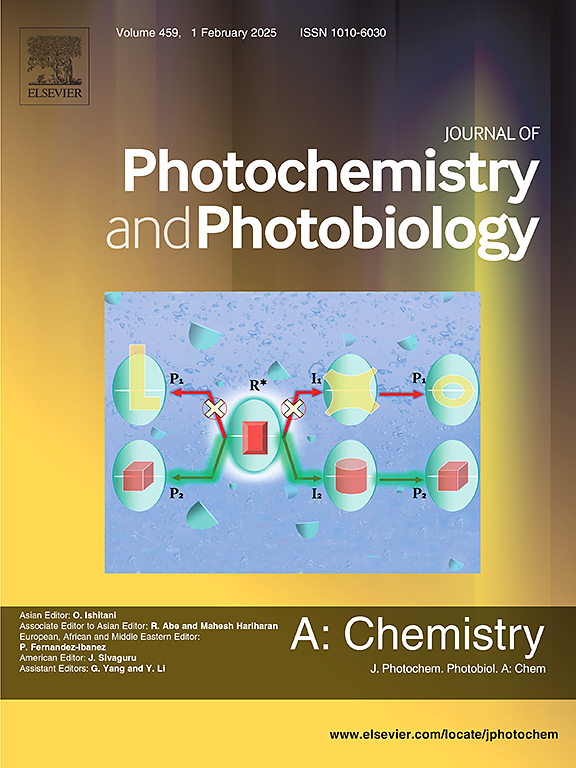通过侧链工程调节苯并双噻唑基线性共轭聚合物的亲水性以改善光催化析氢
IF 4.7
3区 化学
Q2 CHEMISTRY, PHYSICAL
Journal of Photochemistry and Photobiology A-chemistry
Pub Date : 2025-05-31
DOI:10.1016/j.jphotochem.2025.116530
引用次数: 0
摘要
利用共轭聚合物催化剂通过水裂解光催化析氢为可持续能源生产提供了广阔的前景,然而,电荷载流子动力学和界面反应性方面的挑战限制了共轭聚合物的实际应用。本研究系统地研究了亲水侧链工程在优化光催化性能中的作用,通过设计结构同源的基于苯并双噻唑的线性共轭聚合物,B-PBT(丁基侧链)和O-PBT(低聚乙二醇侧链),具有匹配的光吸收光谱和形态。结构表征证实了相同的共轭骨架和半晶体特征,而形态分析显示两种聚合物的类似片状结构。尽管光吸收范围相当,但在可见光下,由于亲水性调制,O-PBT的析氢速率比B-PBT高7倍。接触角测量(O-PBT为34.0°,B-PBT为59.5°)和光电化学分析表明,O-PBT增强了界面亲水性,抑制了电荷重组,降低了电荷转移电阻。这项工作将亲水效应与光吸收和形态因素解耦,建立了侧链工程作为优化有机光催化剂界面反应性和电荷动力学的关键策略。本文章由计算机程序翻译,如有差异,请以英文原文为准。

Side chain engineering for modulating hydrophilicity of benzobisthiazole-based linear conjugated polymer to improve the photocatalytic hydrogen evolution
Photocatalytic hydrogen evolution through water splitting using conjugated polymer catalysts presents a promising prospect for sustainable energy production, however, challenges in charge carrier dynamics and interfacial reactivity limit practical implementation of conjugated polymers. This study systematically investigates the role of hydrophilic side-chain engineering in optimizing photocatalytic performance by designing structurally homologous benzobisthiazole-based linear conjugated polymers, B-PBT (butyl side chains) and O-PBT (oligoethylene glycol side chains), with matched light absorption spectra and morphologies. Structural characterization confirmed identical conjugated backbones and semi-crystalline features, while morphological analysis revealed analogous flake-like architectures for both polymers. Despite comparable light absorption ranges, O-PBT exhibited a 7-fold higher hydrogen evolution rate than B-PBT under visible light, attributed to hydrophilic modulation. Contact angle measurements (34.0° for O-PBT v.s. 59.5° for B-PBT) and photoelectrochemical analyses demonstrated enhanced interfacial water affinity, suppressed charge recombination and reduced charge-transfer resistance in O-PBT. This work decouples hydrophilicity effects from light-absorptive and morphological factors, establishing side-chain engineering as a critical strategy for optimizing interfacial reactivity and charge dynamics in organic photocatalysts.
求助全文
通过发布文献求助,成功后即可免费获取论文全文。
去求助
来源期刊
CiteScore
7.90
自引率
7.00%
发文量
580
审稿时长
48 days
期刊介绍:
JPPA publishes the results of fundamental studies on all aspects of chemical phenomena induced by interactions between light and molecules/matter of all kinds.
All systems capable of being described at the molecular or integrated multimolecular level are appropriate for the journal. This includes all molecular chemical species as well as biomolecular, supramolecular, polymer and other macromolecular systems, as well as solid state photochemistry. In addition, the journal publishes studies of semiconductor and other photoactive organic and inorganic materials, photocatalysis (organic, inorganic, supramolecular and superconductor).
The scope includes condensed and gas phase photochemistry, as well as synchrotron radiation chemistry. A broad range of processes and techniques in photochemistry are covered such as light induced energy, electron and proton transfer; nonlinear photochemical behavior; mechanistic investigation of photochemical reactions and identification of the products of photochemical reactions; quantum yield determinations and measurements of rate constants for primary and secondary photochemical processes; steady-state and time-resolved emission, ultrafast spectroscopic methods, single molecule spectroscopy, time resolved X-ray diffraction, luminescence microscopy, and scattering spectroscopy applied to photochemistry. Papers in emerging and applied areas such as luminescent sensors, electroluminescence, solar energy conversion, atmospheric photochemistry, environmental remediation, and related photocatalytic chemistry are also welcome.

 求助内容:
求助内容: 应助结果提醒方式:
应助结果提醒方式:


